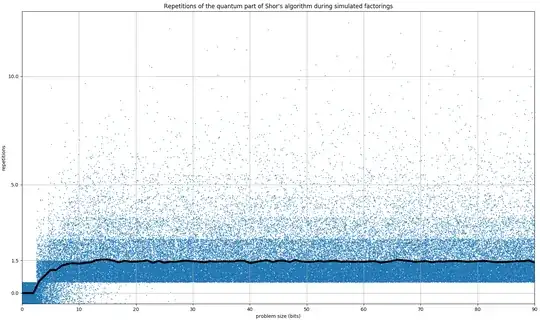This self-answer gives a not-very-good worst case analysis. I'd really rather have a proper distribution of repetition counts.
Probability of a period resulting in factoring
In Shor's original paper, you can find the following statement:
The multiplicative group (mod $p^α$) for any odd prime power $p^α$ is cyclic [Knuth 1981], so for any odd prime power $p_i^{a_i}$, the probability is at most 1/2 of choosing an $x_i$ having any
particular power of two as the largest divisor of its order $r_i$. Thus each of these powers of 2 has at most a 50% probability of agreeing with the previous ones, so all k of them agree with probability at most $1/2^{k−1}$, and there is at least a $1 - 1/2^{k-1}$ chance that the $x$ we choose is good. This scheme will thus work as long as $n$ is odd and not a prime power; finding factors of prime powers can be done efficiently with classical methods
(Oddly, I also found an older version of the paper with a bound of $1-2^{-k}$ instead of $1-2^{1-k}$. Might be an error that was corrected?)
This implies a 50% chance of success of getting a good period (steps 4+5), since all numbers have at least two distinct factors or else can be factored classically.
Probability of a sample determining a period
For getting a good sample (step 3), Shor gives a more complicated bound. If you sample a value with a $k$ that's not relatively prime to the period, the period you recover will be wrong. But integers have a limited number of divisors, and Shor cites a bound:
There are also $r$ possible values for $x^k$, since $r$ is the order of $x$. Thus, there are $r \phi(r)$ states which would enable us to obtain $r$. Since each of these states occurs with probability at least $\frac{1}{3r^2}$, we obtain $r$ with probability at least $\frac{\phi(r)}{3r}$.
Using the theorem that $\phi(r)/r > k/\log \log r$ for some fixed $k$ [17, Theorem 328], this shows that we find $r$ at least a $k/ \log \log r$ fraction of the time.
[17]: G. H. Hardy and E. M. Wright, An Introduction to the Theory of Numbers, Fifth Edition, Oxford University Press, New York (1979).
We know $r < N$, so this proves step 3 introduces at most $O(\lg \lg N)$ repetitions. It seems likely to me that this can be improved (e.g. if you keep replacing $b$ by $b^p$ when you get a bad $p$ that would presumably keep reducing $r$, or maybe that's bad?), and I'm sure someone has explained how to do this in great detail, but I don't know the reference.
"On Shor's Quantum Factor Finding Algorithm: Increasing the Probability of Success and Tradeoffs Involving the Fourier Transform Modulus" seems promising. It discusses using the lcm of two samples in order to get a constant probability of successfully recovering a period (~60%).
I also did some simulation of how many repetitions are needed when the two factors are similarly sized primes, using some basic post-processing, and it appears to converge to 1.5. The following plot is showing a blue dot for each factoring attempt, with a random +-0.5 on each dot's X and Y position so you get a sense of the density in each area. The thick black line is the average.

